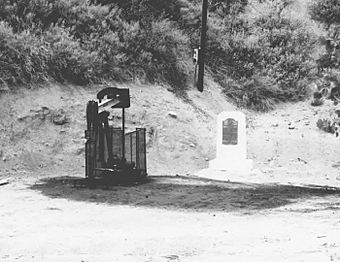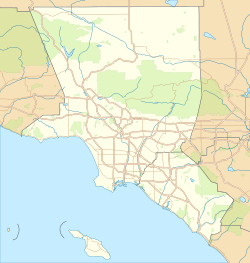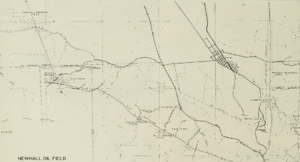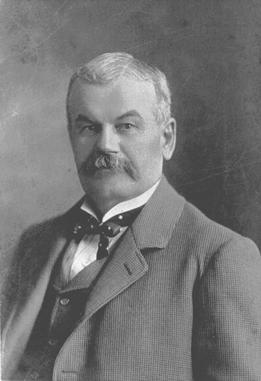Pico Canyon Oilfield facts for kids
|
Well No. 4, Pico Canyon Oil Field
|
|

Well Number 4 in 1961, Pico Canyon Oil Field
|
|
| Nearest city | Newhall, California |
|---|---|
| Area | 850 acres (340 ha) |
| Built | 1876 |
| NRHP reference No. | 66000212 |
Quick facts for kids Significant dates |
|
| Added to NRHP | November 13, 1966 |
| Designated NHL | November 13, 1966 |
Well No. 4, in the Pico Canyon Oilfield, is located about seven miles (11 km) west of Newhall, California. This famous oil well is considered the very first successful oil well in the Western United States. It's also known as the starting point for California's huge oil industry.
Drilled in 1876, Well No. 4 helped turn nearby Newhall into a busy "boomtown." It also led to a smaller town called Mentryville right next to the drilling site. Well No. 4 kept working for an amazing 114 years! It was finally closed down in 1990. Because of its importance, the site was named a National Historic Landmark in 1966. Today, the old town of Mentryville is a ghost town that you can visit as a historic park.
Contents
California's Early Oil History
After the first oil strike at Drake Oil Well in Pennsylvania in 1859, California also had a short period of oil drilling. However, this first oil boom ended in 1867. Oil from the eastern U.S. could be sold for less money. During this first boom, 75 companies drilled 60 wells in California. They spent about $1 million but only made $60,000 worth of oil.
Finding Oil in Pico Canyon
People had known about oil seeps in the Pico Canyon area for a long time. Local Tataviam and Tongva Native Americans used the oil for medicine and healing.
There are different stories about how non-native people rediscovered oil in Pico Canyon. Some say Andrés Pico found oil there in the 1850s. But the Los Angeles Times reported in 1882 that Ramon Peria, a Mexican hunter, found the Pico Oil Spring in January 1865. He was hunting deer and found a dead buck near the spring. The oil's dark green color and thinness caught his eye. He thought it must be valuable. So, he told a friend, Jesus Hernandez, and they claimed the oil site.
Another story says Peria brought some oil to the Mission San Fernando. There, a Dr. Gelsich realized it was petroleum. He quickly started a company to claim the oil. Peria was given a share in the oil company for his discovery. However, he reportedly traded his share for a barrel of spirits and a $20 gold coin. After this discovery, claims were made. But it took almost five more years for the first well to be drilled. It took even longer for the first truly successful commercial well.
Well No. 4: A Landmark Discovery

In 1875, a company called Star Oil Works hired Charles Alexander Mentry (1846-1900). He was put in charge of drilling in Pico Canyon. Mentry was born in France and moved to Pennsylvania when he was seven. He worked in the Pennsylvania oil fields before coming to California in 1873.
Mentry drilled three wells in 1875 and 1876 that looked promising. But the big "gusher" came with the fourth well. Mentry started drilling Well No. 4 in July 1876. On September 26, 1876, he struck oil at a depth of 370 feet (110 m). The well immediately started producing 25 barrels per day (4.0 m3/d) (barrels of oil per day).
Drilling Well No. 4 was very hard. There was no railroad yet, no road into the canyon, and very little water. Also, there were no good tools or machines. Mentry used his mechanical skills to create his own tools. For example, he built a drill-stem from old railroad car axles. He bought these from the Southern Pacific and welded them together.
In 1877, Mentry drilled the well deeper, to 560 feet (170 m). The oil then shot up to the top of the 65-foot (20 m) derrick! This increased production to 150 barrels per day (24 m3/d). After Well No. 4 became a success, Mentry built California's first oil pipeline. It ran from Pico Canyon to the refinery in Newhall. Later, he made it even longer, 50 miles (80 km) to the ocean at Ventura, California.
Well No. 4 kept producing oil for 114 years. It was finally capped in 1990. It was the longest continuously working oil well in the world! When a reporter visited the site in 1962, the caretaker's son showed him the old well. He turned a valve and said, "Still producing after all these years... only about a barrel a week, but look how rich the oil is."
Historic Recognition
Well No. 4 was named a National Historic Landmark in 1966. It was one of the first sites in Los Angeles County to be listed on the National Register of Historic Places.
Pico Canyon's Oil Boom
The success of Well No. 4 was the biggest of any well in California. It caused the state's second oil drilling boom. As a result, California's oil production grew a lot:
- 1879: 568,806 barrels (90,432.9 m3)
- 1880: 1,763,215 barrels (280,328.8 m3)
- 1881: 4,194,102 barrels (666,808.9 m3)
In 1882, the editor of the new Los Angeles Times rode a horse to see the famous Pico Canyon oil wells. As he got closer, he noticed his horse wouldn't drink from the canyon's small rivulet. He found the water was "about half crude oil and half water." The editor described the busy oil region:
There are eight wells now yielding oil, and three more in process of sinking, some in the canyon, some on the hillsides and some on the tops of the peaks, five hundred feet almost perpendicular from base to top... large boilers, heavy machinery, timber, and all the etceteras for oil mining and the comfort of the miners, have been hauled up these almost perpendicular roads... the deepest well on the mountains is a little over 1,500 feet in depth, and none have yet been sank but what have yielded oil in remunerative quantities. A 2-inch iron pipe, about seven miles (11 km) long, runs from Pico canyon to the refinery in Newhall, and through this an average of one hundred and seventy barrels of crude oil is sent every twenty-four hours...
By 1883, Pacific Coast Oil Company had bought out other companies in Pico Canyon. This company later became Standard Oil of California. They had 30 wells that were said to produce 500 barrels per day (79 m3/d). When the Times sent another reporter in 1883, he found a camp where engines ran day and night. It employed 80 to 100 men, mostly "robust, healthy young men from the mountain districts of Pennsylvania."
In 1895, a California state report said that Pacific Coast Oil Company had 40 wells working in Pico Canyon. They were producing 500 barrels per day (79 m3/d). One well alone had produced 1,500,000 barrels (240,000 m3) of oil.
Mentryville: A Boomtown's Legacy
A boomtown called Mentryville was built close to Well No. 4. The town was named after Charles Alexander Mentry. He lived there and managed the Pico Canyon oil operations until he died in 1900. People said he treated the workers with respect, and there was never a strike. When Mentry died, almost everyone from the town (over 200 people) went to Los Angeles for his funeral. They brought a large flower arrangement shaped like an oil derrick.
During the 1930s, most people left Mentryville. Many took their houses apart, board by board, and moved them. By 1962, Mentryville had become a ghost town. Only a caretaker family lived in Mentry's old 13-room house. A visitor that year reported that "rusted oil equipment cluttered the canyon." Fallen derricks were rotting, and the cemetery was "choked with weeds, hidden and forgotten."
In 1995, Chevron gave the Mentryville site and 800 acres (320 ha) of Pico Canyon to the Santa Monica Mountains Conservancy. This created the Mentryville and Pico Canyon Parks. A group called the Friends of Mentryville was formed. They work to restore the buildings and open the old town as a historic park.
California Historical Landmark Markers
California Historical Landmark Marker No. 516 at the site tells about Well No. 4:
NO. 516 WELL, CSO 4 (PICO 4) – On this site stands CSO-4 (Pico No. 4), California's first commercially productive well. It was spudded in early 1876 under direction of Demetrious G. Scofield who later became the first president of Standard Oil Company of California, and was completed at a depth of 300 feet on September 26, 1876, for an initial flow of 30 barrels of oil a day. Later that year, after the well was deepened to 600 feet with what was perhaps the first steam rig employed in oil well drilling in California, it produced at a rate of 150 barrels a day – it is still producing after 77 years (1953). The success of this well prompted formation of the Pacific Coast Oil Company, a predecessor of Standard Oil Company of California, and led to the construction of the state's first refinery nearby. It was not only the discovery well of the Newhall Field, but was a powerful stimulus to the subsequent development of the California petroleum industry.
California Historical Landmark Marker No. 516-2 nearby tells about Mentryville:
NO. 516-2 MENTRYVILLE – Named after pioneer oil developer Charles Alexander Mentry, who in 1876 drilled the first successful oil well in California. His restored home and barn and Felton School remain here where the Star Oil Company, one of the predecessors of Standard Oil of California, was born.
Images for kids








